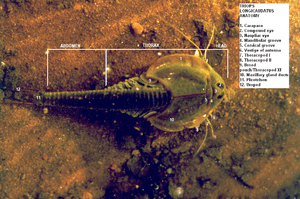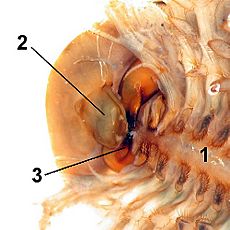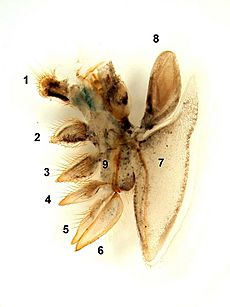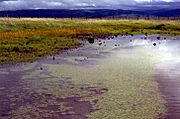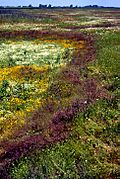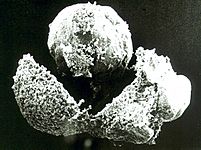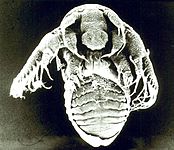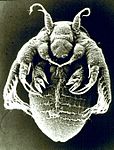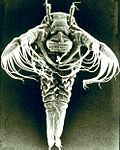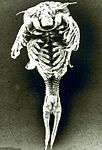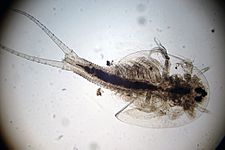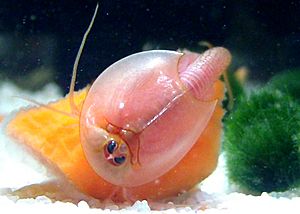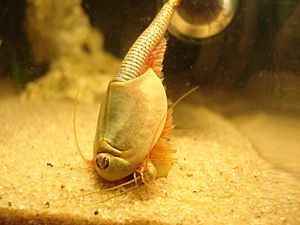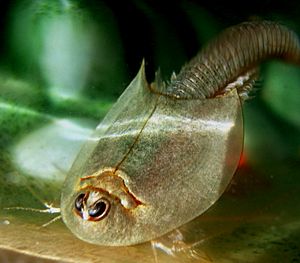Triops longicaudatus facts for kids
Quick facts for kids Triops longicaudatus |
|
|---|---|
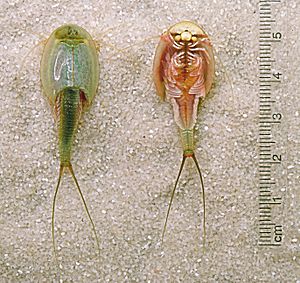 |
|
| Scientific classification | |
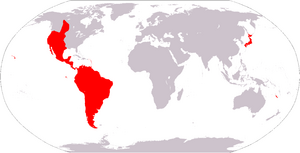 |
|
| The range of Triops longicaudatus | |
| Synonyms | |
|
Apus longicaudatus LeConte, 1846 |
Triops longicaudatus is a small freshwater animal. People often call it the American tadpole shrimp or just tadpole shrimp. It is a type of crustacean, which means it's related to crabs and shrimp. It looks a bit like a tiny horseshoe crab.
This creature has a long body with many parts. It has a flat, shield-like brown shell called a carapace that covers most of its front body. It also has two long tails at the back. The name Triops comes from Greek words meaning "three eyes." Longicaudatus is Latin for "long-tailed," which describes its long tail parts.
Triops longicaudatus lives in freshwater ponds and pools. They often live in places where not many other animals can survive. Like its cousin, Triops cancriformis, the tadpole shrimp is known as a living fossil. This is because its body shape has not changed much in the last 70 million years. It looks almost exactly like its ancient fossil relatives. This makes Triops longicaudatus one of the oldest animal species still alive today!
Contents
What is a Triops?
Triops longicaudatus belongs to a group of crustaceans called Branchiopoda. Most animals in this group live in freshwater and have gills on their legs. The Branchiopoda group includes fairy shrimp, cladocerans, clam shrimps, and tadpole shrimp. Their group name means "leaf-footed" because their legs are flat and look like leaves.
Body Parts of a Triops
Triops longicaudatus is usually greyish-yellow or brown. It is different from some other species because it does not have a second maxilla (a type of mouthpart). It can grow up to 75 mm (3.0 in) long, including its long tail parts. Its tail parts, called cercopods, can be almost as long as the rest of its body.
The head of a Triops longicaudatus has five sections. Its main body is not clearly split into a chest (thorax) and a belly (abdomen). Most of its body sections have legs. The first eleven body sections each have one pair of legs. After that, some sections are joined together, like in millipedes. These joined sections can have up to six pairs of legs each. The very end of the body has no legs.
The Carapace (Shell)
A carapace is present on the Triops. This is a fold of the body wall that covers the front part of its body. It acts like a shield.
The Head
On top of the head, Triops longicaudatus has two compound eyes. They are very close together and look almost like one eye. It also has a "third eye" called an ocellus between them. This third eye is deeper inside the head. You can easily see all three eyes through the shell covering the head.
On the underside of the head, there is a clear spot that lets light reach the third eye. The Triops has small, thin first antennae (feelers) and similar second antennae, but these second ones do not work. It has large, strong mandibles (jaws) with brown teeth. These jaws open and close to chew food.
The Thorax (Body with Legs)
The front part of the thorax has eleven sections, each with a pair of legs. None of these legs are changed for feeding. The back part of the thorax has 16 to 25 sections that are not fully separated. Each of these sections can have up to six pairs of legs. In total, a Triops can have 54 to 66 limbs!
Most of the legs look alike, but the first pair is special. It is long and has a claw-like shape, used for feeling things. All the other legs help with eating, breathing, and moving. In female Triops, the eleventh pair of legs is changed into special pouches for carrying eggs.
The Abdomen (Tail End)
The last 5 to 14 sections at the end of the body do not have any legs. At the very end of the body, there is a part called a pleotelson. This is connected to two long, multi-part tail structures called uropods.
How Triops Eat
Tadpole shrimps eat by stirring up mud and water with their front legs. Tiny hairs on their legs help them filter out food particles. These particles are then moved into a groove under their body and held together with a sticky liquid. Then, they swallow the food with their very small mouth. Their mouth is deep under their body. While they can break up plant roots or dead fish, they cannot chase and eat prey bigger than themselves.
Inside a Triops
The heart of a tadpole shrimp is a long tube located in the front eleven body sections. Sometimes, their blood has hemoglobin, which can make the crustacean look pink. Their excretory organs (for getting rid of waste) are glands located near their second maxilla. These glands mainly help control the amount of water and salt in their body. Waste like ammonia leaves their body through their gills.
Reproduction and Life Cycle
Reproduction
Triops longicaudatus can reproduce in a few different ways. They can reproduce sexually, but this is not common because most groups have many more males or females. The most common way they reproduce is through parthenogenesis. This means the eggs develop without being fertilized by a male. Some groups of Triops are hermaphrodites, meaning they have both male and female parts and can fertilize each other. Different groups of Triops use different ways to reproduce.
Female Triops carry their eggs in special egg sacs on their eleventh pair of legs for several hours. The eggs are released in groups and have a thick shell. These eggs can survive freezing temperatures and dry periods. This helps the Triops population survive from one season to the next. The eggs must dry out completely before they can hatch when water returns. They can stay in a resting state, called diapause, for up to 20 years! These tough eggs may have helped Triops longicaudatus survive many natural disasters and mass extinctions throughout history.
Life Cycle
To live their full lives, tadpole shrimps need the temporary pools they live in to change. During the dry season (summer and autumn), their eggs wait in the dry ground. When the pools fill with rainwater in winter and spring, the eggs hatch. The young Triops then eat fairy shrimps and other small creatures.
The first stage of a Triops larva is orange and has one eye and six legs. It grows through several stages, shedding its outer skin (exoskeleton) each time. As Triops grow, they get more body sections and legs. They slowly change from orange to greyish-brown. In about eight days, they become adults and lay their own eggs. Adult Triops die when their pools dry up. If the pool does not dry up, Triops usually live for about 20 to 90 days.
Where Triops Live and What They Do
T. longicaudatus is the most common type of tadpole shrimp. You can find them in western North America, South America, Japan, South Korea, and some Pacific Islands. They are most active when the water is around 20 °C (68 °F). They usually scratch the mud at the bottom of pools, looking for food.
What Triops Eat
Tadpole shrimps are omnivorous, meaning they eat both plants and animals. They might eat algae, insects, and other dead organic material. They are known to chase very small fish, tadpoles, and worms. Generally, they will eat anything organic that is smaller than them. This can even include their own smaller siblings, as they can be cannibalistic. In turn, Triops longicaudatus are eaten by frogs and birds.
Triops and Humans
This species is helpful to humans because they eat the larvae (young) of Culex mosquitoes, which can carry the West Nile virus. In Japan, they are used to eat weeds in rice fields. In Wyoming, if you find Triops longicaudatus, it often means that spadefoot frogs are likely to hatch there too.
You can buy dried Triops eggs in kits to raise them as pets in aquariums. They are sold under names like "aquasaurs" or "triops." These are usually the greenish-brown kind, but red ones are also popular among hobbyists. Pet Triops are often kept in tanks and fed carrots, shrimp pellets, and dried shrimp. They can also eat live shrimp and daphnia. Since they can eat almost anything, people also feed them lunch meat, potatoes, or crackers. They also graze on algae and other grime from the tank bottom and sides.
Where Triops are Found
Triops longicaudatus is found across North America. In Canada, they live only in Alberta, Saskatchewan, and Manitoba. They are common throughout the contiguous United States, Mexico, and Hawaii, but not Alaska. Tadpole shrimps can also be found in parts of South America (like Argentina and the Galápagos Islands), in the West Indies, and on Pacific Islands like Japan and New Caledonia.
See also
 In Spanish: Triops longicaudatus para niños
In Spanish: Triops longicaudatus para niños




